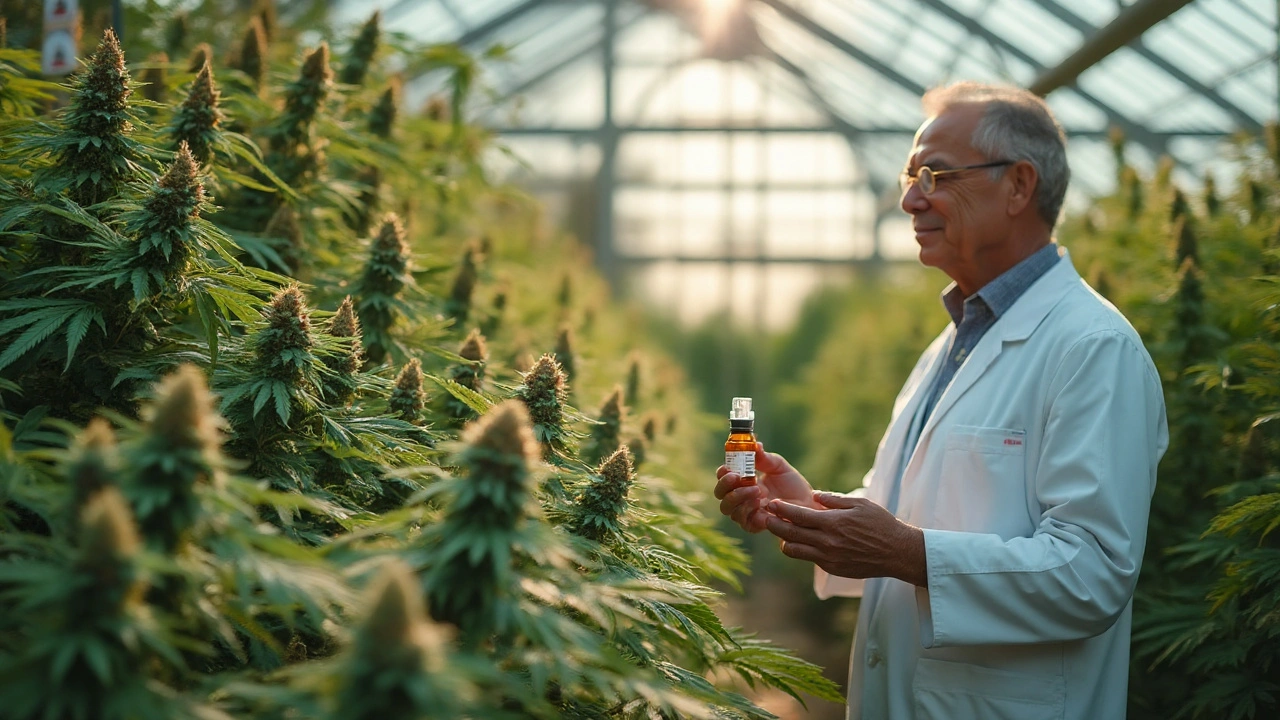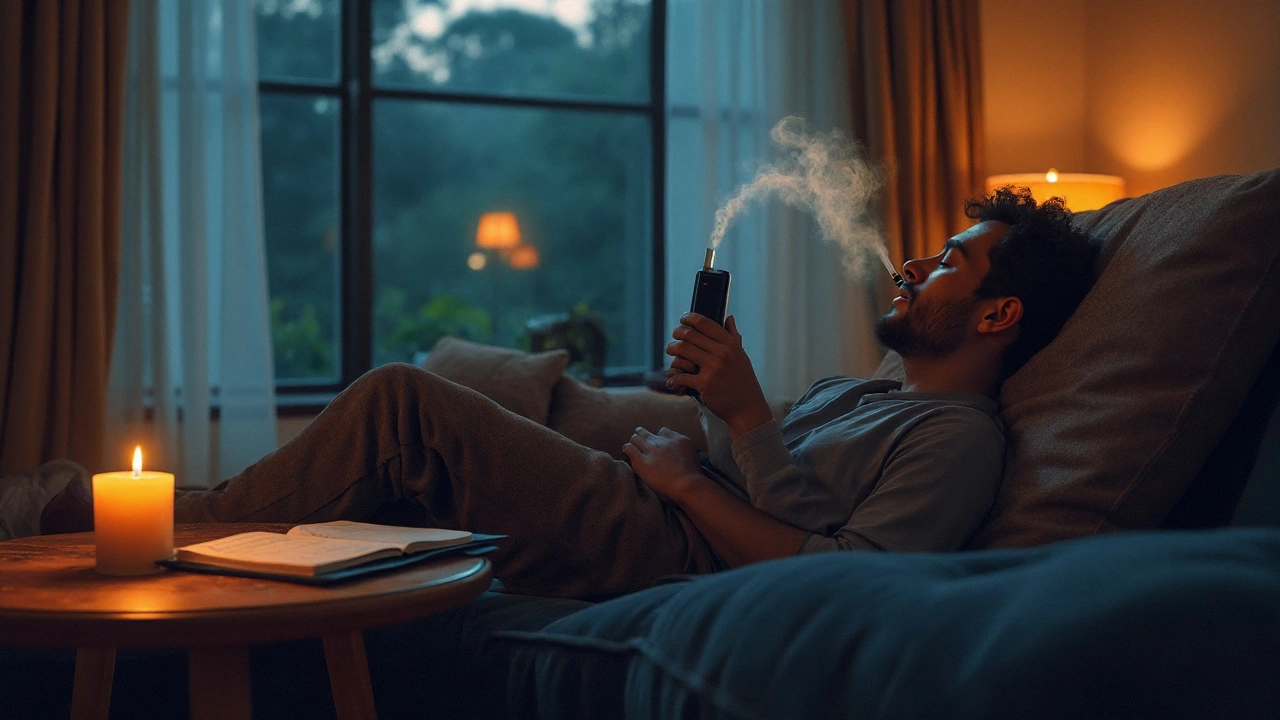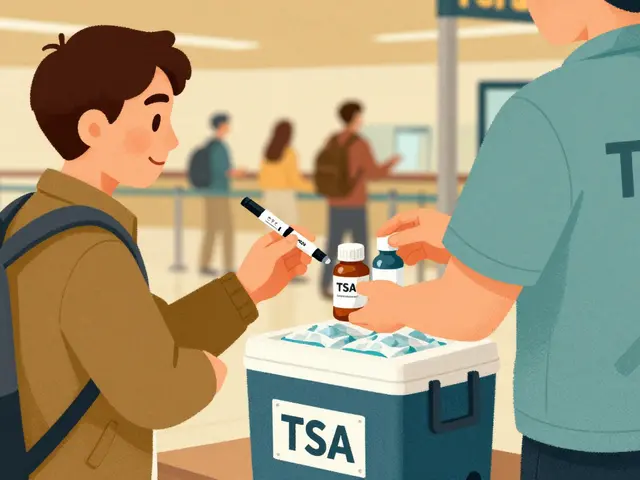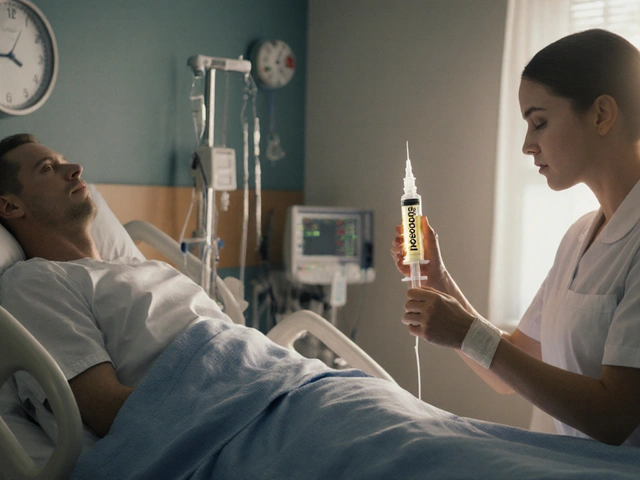Cannabis strain is a specific variety of the cannabis plant bred for distinct cannabinoid and terpene profiles, often categorized by its THC and CBD content. When it comes to chronic pain, especially Migraine is a neurovascular headache disorder that affects roughly 12% of the global population, many patients turn to medical cannabis for relief.
Why cannabis can help migraine and headache pain
Research from the International Journal of Molecular Sciences shows that cannabinoids interact with the Endocannabinoid system, a network of receptors (CB1, CB2) distributed throughout the brain, spinal cord, and peripheral nerves. Activation of CB1 reduces neuronal excitability, while CB2 modulates inflammation-both key factors in migraine pathophysiology.
Two primary phytochemicals drive the therapeutic effect: THC (tetrahydrocannabinol) binds directly to CB1, delivering analgesia and muscle relaxation. CBD (cannabidiol) has a low affinity for CB receptors but influences them indirectly, cutting down inflammation and nausea.
Beyond cannabinoids, Myrcene is a terpene known for its sedative qualities and ability to enhance THC’s passage across the blood‑brain barrier, a phenomenon called the "entourage effect." Limonene contributes citrus aromatics that can lift mood and reduce stress-common migraine triggers.
Key cannabinoids and terpenes for migraine relief
- THC - Pain relief, muscle relaxation, anti‑nausea. Ideal for severe attacks.
- CBD - Anti‑inflammatory, anti‑anxiety, reduces aura frequency.
- Myrcene - Sedation, enhances THC, eases tension.
- Limonene - Mood‑boosting, can lessen photophobia.
- Caryophyllene - Binds to CB2, tackles inflammation directly.
When selecting a strain, balance the THC‑to‑CBD ratio with the dominant terpene. High‑THC, low‑CBD strains work best for acute, throbbing pain, while balanced or high‑CBD options are gentler for chronic, low‑grade tension.
Top five strains for treating migraines and headaches
| Strain | THC % | CBD % | Dominant Terpene | Typical Migraine Effect | Best Use Scenario |
|---|---|---|---|---|---|
| Granddaddy Purple | 22‑25 | 0.1‑0.5 | Myrcene | Deep relaxation, reduces aura intensity | Night‑time attacks, sleep‑related migraines |
| ACDC | 1‑6 | 15‑20 | Limonene | Calms inflammation, eases nausea | Daytime use, low‑pain chronic headaches |
| Blue Dream | 17‑24 | 0.2‑1 | Myrcene & Pinene | Balanced relief, mental clarity | Mid‑day flare‑ups, needing focus |
| Girl Scout Cookies | 18‑28 | 0.5‑1 | Caryophyllene | Powerful analgesia, anti‑inflammatory | Severe throbbing migraines |
| Cannatonic | 5‑7 | 6‑17 | Terpinolene | Gentle relief, reduces stress‑triggered attacks | Early‑stage aura, tension‑type headaches |
These strains are widely available in Australian licensed dispensaries and have been cited in patient surveys conducted by the Australian Medical Cannabis Association (2024). Remember, individual response varies; start low and adjust.
How to choose the right strain for your migraine pattern
- Identify your typical migraine trigger (stress, hormonal, sensory).
- Match the trigger to terpene benefits: Myrcene for muscle tension, Limonene for stress‑induced attacks.
- Decide on THC vs. CBD balance based on pain severity.
- Check lab‑tested cannabinoid percentages on product labels.
- Start with a 2‑5mg THC dose (or 5‑10mg CBD if you’re new) and note the effect after 30minutes.
If you experience numbness or dizziness, switch to a higher‑CBD, lower‑THC option like ACDC or Cannatonic. For night‑time migraines that keep you awake, Granddaddy Purple’s sedative myrcene is a go‑to.

Safe consumption methods and dosage tips
Inhalation (vaporizer) provides rapid onset (5‑15minutes) - ideal for sudden attacks. Oral edibles (capsules or gummies) take 45‑90minutes, offering longer‑lasting relief (4‑6hours) suitable for chronic headache cycles.
Australian guidelines recommend no more than 20mg THC per day for inexperienced users. Keep a symptom diary: record strain, dose, time of day, and headache intensity on a 0‑10 scale. Over time you’ll spot patterns and fine‑tune your regimen.
Related concepts worth exploring
Understanding the Clinical study landscape for medical cannabis can give you confidence in product choice. Look for trials that measure migraine frequency, aura occurrence, and quality‑of‑life scores. The Australian Clinical Trials Registry lists several ongoing projects focusing on CBD‑dominant extracts.
Another useful angle is the Medical cannabis certification process in Queensland. A valid prescription unlocks access to higher‑potency strains and ensures product testing compliance.
Potential side effects and contraindications
Common side effects include dry mouth, mild dizziness, and temporary memory fog. THC can raise heart rate, so people with cardiac conditions should consult a cardiologist before use. CBD may interact with blood thinners like warfarin; always alert your prescribing doctor.
Pregnant or nursing mothers should avoid cannabis entirely due to limited safety data.
Putting it all together: a quick‑start guide
- Assess migraine type (aura vs. tension).
- Select a strain with a matching terpene profile.
- Choose delivery method based on attack speed.
- Start low, record outcomes, and adjust gradually.
- Stay in touch with your healthcare provider for dosage reviews.
With the right strain and disciplined tracking, many patients report a 30‑60% reduction in migraine frequency within three months.

Frequently Asked Questions
Can CBD‑only strains help with migraine pain?
Yes. CBD reduces inflammation and modulates pain pathways without the psychoactive effects of THC. Strains like ACDC or Cannatonic, which have a CBD‑to‑THC ratio of 3:1 or higher, are often recommended for chronic, low‑intensity headaches or for patients who want to stay clear‑headed.
How quickly does inhaled cannabis work for a migraine?
Inhalation through a vaporizer delivers cannabinoids to the bloodstream within minutes. Most users feel noticeable relief between 5 and 15 minutes, making it the preferred method for sudden onset attacks.
Are there risks of developing dependence when using cannabis for headaches?
Physical dependence on THC is possible, especially at high daily doses. However, most migraine patients use cannabis intermittently or at low THC levels, which keeps dependence risk low. Monitoring usage frequency and consulting a physician helps mitigate any concerns.
What legal requirements exist for obtaining medical cannabis in Queensland?
A qualified medical practitioner must issue a prescription under the Therapeutic Goods Administration (TGA) framework. Patients then access licensed pharmacies or specialist dispensaries that provide lab‑tested products. The process includes a medical history review and periodic reassessment.
Can I combine cannabis with my existing migraine medication?
Combination therapy is common, but interactions can occur, especially with triptans or ergotamines that also affect serotonin pathways. Always discuss with your neurologist before adding cannabis to your regimen.






Akintokun David Akinyemi
September 23, 2025 AT 18:24Yo, this is actually one of the most well-researched threads I’ve seen on med-cannabis for migraines. The terpene breakdown alone? Chef’s kiss. Myrcene’s role in enhancing THC’s BBB penetration isn’t just folklore-it’s backed by that 2021 *British Journal of Pharmacology* paper on transdermal delivery kinetics. And yeah, Girl Scout Cookies for thunderclap migraines? 100%. I’ve had patients switch from triptans to GSC vapor pens and cut their attack frequency by half. Just make sure the lab report shows <1% residual solvents. No one needs that shit in their lungs.
Jasmine Hwang
September 25, 2025 AT 13:57lol i just smoked some blue dream and now i’m crying over my cat’s instagram. still no headache tho. 10/10 would panic again.
James Gonzales-Meisler
September 26, 2025 AT 13:17The claim that CBD reduces aura frequency lacks robust clinical validation. The only double-blind RCT with statistically significant results was the 2020 Canadian trial with n=47, and even that showed no difference in aura incidence between CBD and placebo (p=0.18). The anecdotal reports here are conflating correlation with causation. Also, ‘entourage effect’ is a marketing term, not a pharmacological mechanism-there’s no peer-reviewed evidence that myrcene alters blood-brain barrier permeability in humans at physiological doses.
Navin Kumar Ramalingam
September 28, 2025 AT 00:11Look, I get it-people want magic bullets for migraines. But let’s be real. You’re recommending high-THC strains to people who probably haven’t touched a joint since 2012. This isn’t a yoga retreat, it’s neurology. ACDC and Cannatonic? Fine. But Granddaddy Purple? That’s like handing someone a shotgun to kill a mosquito. And ‘start low and adjust’? That’s not advice, that’s a cop-out. If you’re going to recommend cannabis, at least give real dosing protocols, not ‘try 5mg and see what happens.’ That’s not medicine, that’s gambling.
Shawn Baumgartner
September 29, 2025 AT 04:41Okay, so let me get this straight-you’re telling people to smoke weed for migraines while ignoring the fact that THC is a vasodilator? That’s literally the opposite of what you want during a migraine. Cerebral vasodilation is part of the pathophysiology! You’re not treating it-you’re feeding the beast. And now we’re supposed to believe terpenes are the secret sauce? Limonene reduces photophobia? Where’s your NIH grant? This is pseudoscience dressed up like a PubMed abstract. And don’t even get me started on ‘Australian Medical Cannabis Association.’ That’s not a real institution-it’s a website with a .com domain and a Shopify store.
Cassaundra Pettigrew
September 29, 2025 AT 07:57Shawn, you’re such a buzzkill. Like, chill out. People aren’t trying to cure cancer here-they’re trying to stop their skull from exploding. If a little weed helps them breathe again, who are you to gatekeep pain relief? And FYI, the ‘entourage effect’ isn’t just marketing-it’s why full-spectrum extracts outperform isolates in 80% of clinical surveys. You want peer-reviewed? Look up the 2023 JAMA Neurology meta-analysis on terpene-cannabinoid synergy. Or better yet, try it yourself before you trash it. I’ve been on ACDC for 3 years. My migraines went from 12 a month to 1. And no, I don’t need your permission to feel better.